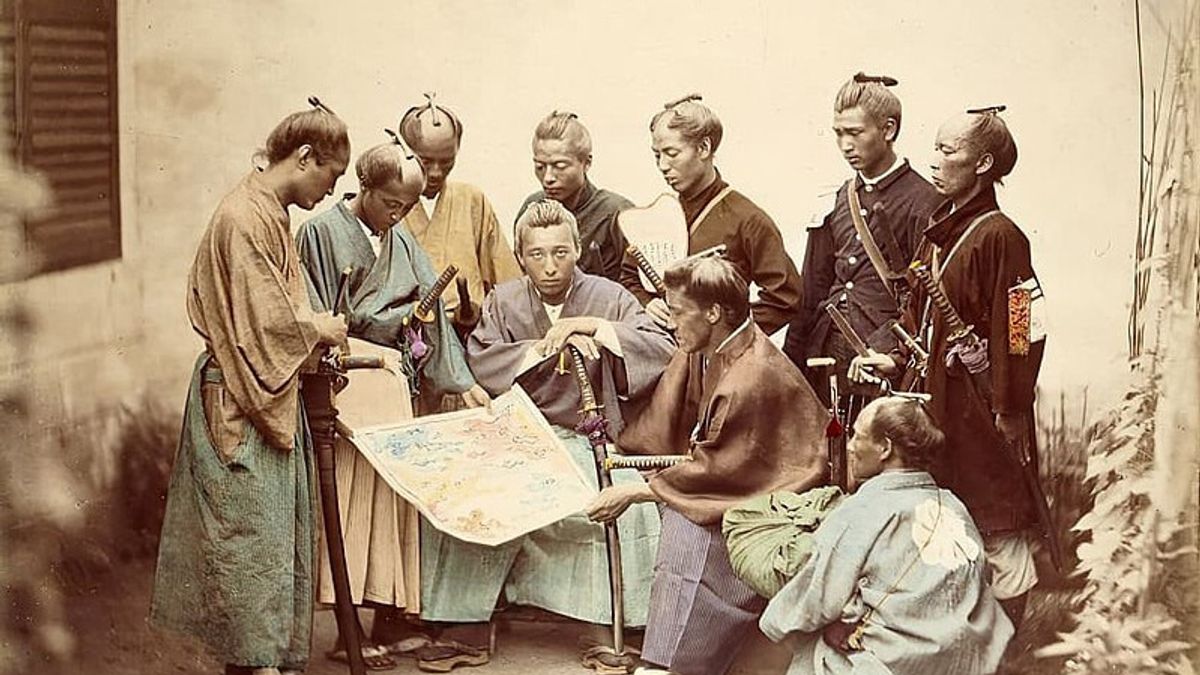JAKARTA - Japan was once an ultra-conservative country when it was ruled by the shogun for 200 years, from the 16th to the 18th century. This country absolutely does not allow foreigners to enter the country. But Japan evolved when the Boshin War broke out and ushered Japan into a more modern country.
The civil war started on January 27, 1868, today 153 years ago. The Boshin War was a civil war in Japan, between the ruling forces, the Tokugawa Shogunate and those who wanted to return political power to the Imperial Palace. The Boshin War lasted only two years, between 1868 and 1869.
This war started from the dissatisfaction of the aristocrats and young samurai with the shogunate rule. Meanwhile, the increasing Western influence in the economy led to a decline similar to that of other Asian countries at that time.
To that end, the western samurai alliance, especially the Choshu, Satsuma, and Tosa domains, and court officials secured control of the Imperial Palace. They also tried to influence the young Emperor Meiji.
Quoting Though Co, the Shogunate had an army of more than 15,000 and mostly consisted of traditional samurai. They attacked the Satsuma and Choshu forces at the southern entrance to Kyoto, the imperial capital.
Meanwhile, on the Choshu and Satsuma side there were only 5,000 troops. But thanks to the support of modern weaponry including rifles, howitzers and even Gatling guns, they excel. The victory of the pro-imperial forces within two days led several important daimyo to turn from the shogun to the emperor.
On February 7, 1868, the former Tokugawa shogun Yoshinobu left Osaka and retreated to the capital, Edo (Tokyo). Desperate by his escape, the shogunate gave up their defense of Osaka Castle, which fell to pro-imperial forces the following day.
In another blow to the shogunate, foreign ministers of western powers decided in early February to recognize the emperor's government as the legitimate government of Japan. However, this did not prevent samurai on the side of the empire from attacking foreigners in separate incidents as anti-foreign sentiment ran high.
The birth of a new era
Saigo Takamori, who became known as The Last Samurai, led an army of emperors across Japan to besiege Edo in May 1869. The shogun's capital surrendered unconditionally a short time later.
Despite the shogunate's defeat of speed, the shogun's naval commander refused to surrender his eight ships. They hoped to join the Aizu clan samurai and other northern domain warriors, who were still loyal to the shogunate rule.
The Northern Coalition was brave but relied on traditional methods of combat and weaponry. It took a heavily armed imperial force from May to November 1869 to finally defeat the stubborn northern resistance. On November 6, 1896, the last Aizu samurai surrendered.
The transfer of power made Japan change. Two weeks before capturing the last samurai, the empire officially began the Meiji Period. The former shogun's capital, Edo, was renamed Tokyo. Tokyo means "eastern capital."
After the fighting ended, the old feudal regime was completely dismantled. The administrative reorganization was largely completed in 1871, when the domain was officially abolished and replaced with the prefectural system that is still in effect today.
All the privileges of the feudal class were abolished. Also in 1871, a national army was formed which was strengthened two years later by universal conscription law.
The new government pursued policies to unify the monetary and tax systems, with the agricultural tax reform in 1873 being its main source of revenue. Another reform was the introduction of universal education in the country in 1872, which initially emphasized Western learning.
Modernization of Japan
The Meiji period changed Japan from all aspects, from economic, social, and political. Even though the economy still relies on agriculture, industrialization has become the main goal of the government which directs the development of strategic industries, transportation and communication.
Some progress in the industrial sector began to appear. As reported by the Britannica, Japan began building the first railroad in 1872 and by 1890 the country already had more than 2,250 km of tracks.
Telegraph lines connecting all major cities existed in 1880. Private companies were supported by government finance and assisted by banking system institutions in 1882.
Such modernization efforts require Western science and technology. Under the banner of Civilization and Enlightenment (Bunmei kaika), Western culture, from current intellectual trends to clothing and architecture, was widely promoted in Japan.
In the early 20th century, the aims of the Meiji Period had been largely achieved. Japan was then on its way to becoming a modern industrial country. Unequal treaties that had granted legal and economic rights to foreign powers through extraterritoriality were revised in 1894.
With the Anglo-Japanese Alliance in 1902 and its victories in two wars (over China in 1894–1895 and Russia in 1904–1905), Japan won respect in the eyes of the world. Since then Japan has emerged on the international scene for the first time as a major world power.
The English, Chinese, Japanese, Arabic, and French versions are automatically generated by the AI. So there may still be inaccuracies in translating, please always see Indonesian as our main language. (system supported by DigitalSiber.id)













